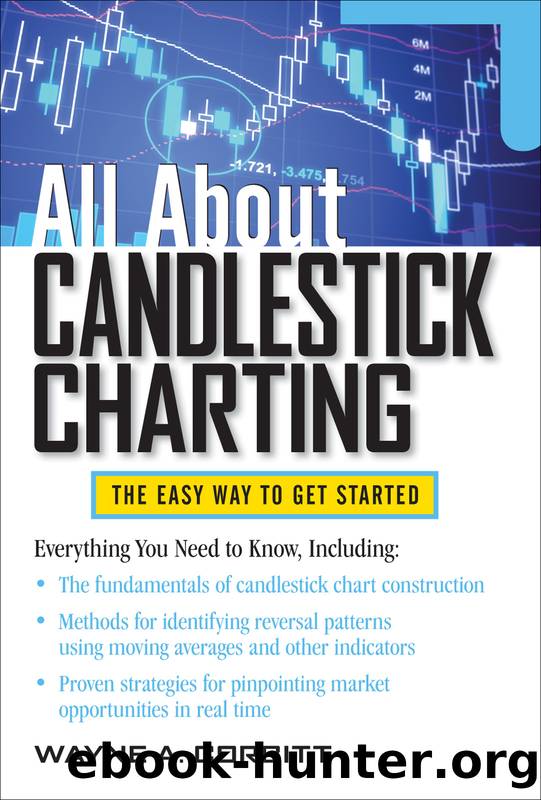All About Candlestick Charting by Wayne A. Corbitt

Author:Wayne A. Corbitt
Language: eng
Format: epub
Publisher: McGraw Hill LLC
Published: 2012-01-15T00:00:00+00:00
STOCHASTIC OSCILLATOR
A stochastic oscillator shows where the latest close is in relation to the price range over the desired period. It was introduced by George Lane and is a favorite among many traders because of its standardized scale and easy to follow signals.
The theory behind the stochastic oscillator is based on the premise that price closes closer to the upper end of its trading range in an uptrending market and closes nearer to the bottom of its trading range in a downtrending market. As price trends mature, closes near the extreme of the period become less common, alerting a trader that a change in trend may be imminent.
Construction of the stochastic consists of two oscillators called %K and %D. The data needed for %K are the current close along with the highest and lowest prices for the period being used. For example, in constructing a five-period %K, the current close, the highest high for the last five periods, and the lowest low for the last five periods would be used. The formula is as follows: %K = 100 Ã [(C â Ln) /(Hn â Ln)], where Ln is the lowest low over the last n periods and Hn is the highest high over the last n periods. %D is a smoothed version of %K. Its calculation equates to a moving average of %K values. %D is typically a three-period smoothed version of %K, especially in shorter-term time frames, but it is perfectly acceptable to set oneâs own %D length.
In many charting packages, the stochastic oscillator that is used is referred to as a slow stochastic. A slow stochastic is a smoothed version of %K (the usual default is three periods), with a %D that is usually a three-period smoothing of the already smoothed %K. The setting for a five-period slow stochastic would be 5, 3, 3 with the 5 representing the number of periods used in the %K calculation, the first 3 representing the smoothing of %K (three periods), and the second 3 representing the smoothing of the smoothed %K line that yields the %D (also three periods). Thus, in effect, the %D in a slow stochastic is a double-smoothed version of the original %K. The reason for using the slow stochastic is that it is less volatile and gives more reliable trading signals than does the raw version of %K. The stochastic examples below all use the slow stochastic.
The stochastic is known as a banded oscillator because it has set levels that denote overbought and oversold momentum levels. The default values are 80 for overbought and 20 for oversold. In many cases, however, the range for overbought and oversold levels tends to shift, depending on the market trend. Also, the crossover of %K and %D is used by many as a timing signal for market entry and/or exit, but these crossover signals also can provide whipsaw signals, or rapid signals that switch from one direction to another over a short period. The examples below will reference the %K line (the solid line) when referring to the stochastic oscillator.
Download
This site does not store any files on its server. We only index and link to content provided by other sites. Please contact the content providers to delete copyright contents if any and email us, we'll remove relevant links or contents immediately.
Hit Refresh by Satya Nadella(8983)
The Compound Effect by Darren Hardy(8719)
Change Your Questions, Change Your Life by Marilee Adams(7546)
Nudge - Improving Decisions about Health, Wealth, and Happiness by Thaler Sunstein(7442)
The Black Swan by Nassim Nicholas Taleb(6925)
Deep Work by Cal Newport(6793)
Daring Greatly by Brene Brown(6356)
Rich Dad Poor Dad by Robert T. Kiyosaki(6298)
Principles: Life and Work by Ray Dalio(6102)
Man-made Catastrophes and Risk Information Concealment by Dmitry Chernov & Didier Sornette(5862)
Playing to Win_ How Strategy Really Works by A.G. Lafley & Roger L. Martin(5704)
Digital Minimalism by Cal Newport;(5570)
Big Magic: Creative Living Beyond Fear by Elizabeth Gilbert(5541)
The Myth of the Strong Leader by Archie Brown(5358)
The Slight Edge by Jeff Olson(5309)
Discipline Equals Freedom by Jocko Willink(5229)
The Motivation Myth by Jeff Haden(5113)
Stone's Rules by Roger Stone(4981)
The Laws of Human Nature by Robert Greene(4909)
